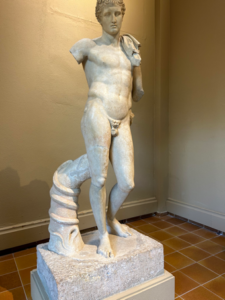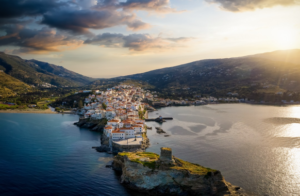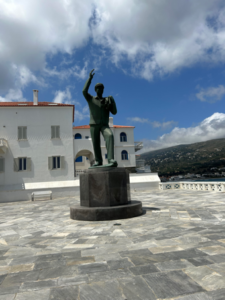A visit to the Aegean islands of Greece is always an experience as each one of them is so different from the other. The island of Andros is only a 2-hour boat ride from the port of Rafina.
Andros (Greek: Άνδρος) is the northernmost island of the Greek Cyclades (Greek: Κυκλάδες νήσοι, which means ‘encircling islands’) in the Aegean Sea. The Cyclades include about 220 small and large islands, forming a circle around the sacred island of Delos. Some of the major islands are Amorgos, Anafi, Andros, Antiparos, Delos, Ios, Kea, Kimolos, Kythnos, Milos, Mykonos, Naxos, Paros, Folegandros, Serifos, Sifnos, Sikinos,Syros, Tinos and Santorini. The largest island of the Cyclades is Naxos, but the most populated is Syros. Most of the smaller islands are uninhabited.
 The Cyclades are not known for their lush vegetation, but rather for the contrasting combination of white and blue of the sea and sky. Andros on the other hand, is not only mountainous, but one of the greenest islands in the Aegean as it has many waterfalls and steams, and its gorges and slopes are full of vegetation dotted with small, picturesque villages. These areas have now become a part of the river trails of Andros. Another interesting aspect is the practice of terraced farming because of the steep hilly slopes and the use of slate slabs to divide the farming plots. The houses are also built from the local stone and slate slabs with flat roofs and whitewashed to give the contrast with the blue of the sea and sky.
The Cyclades are not known for their lush vegetation, but rather for the contrasting combination of white and blue of the sea and sky. Andros on the other hand, is not only mountainous, but one of the greenest islands in the Aegean as it has many waterfalls and steams, and its gorges and slopes are full of vegetation dotted with small, picturesque villages. These areas have now become a part of the river trails of Andros. Another interesting aspect is the practice of terraced farming because of the steep hilly slopes and the use of slate slabs to divide the farming plots. The houses are also built from the local stone and slate slabs with flat roofs and whitewashed to give the contrast with the blue of the sea and sky.
 The name of the island goes back to Greek mythology. The union of the Sun God Apollo and Rhoeo, daughter of Stafylos, son of the god of wine Dionysus, produced Anius, whom Apollo made king of Delos. Anius had three daughters and two sons, Andros and Mykonos, who went on to rule and gave the names to the respective islands. The island has been inhabited since prehistoric times, gaining importance during Archaic and Classical times, with Dionysus being the main god of worship. The Geometric years (10th-8th century BC) were a period of prosperity for Andros as revealed in the two cities of Zaghora and Ypsili on the west coast of the island. Archaeological excavations have also taken place around Palaeopolis (it means ‘old city’), the ancient capital of Andros where its port and market have sunk into the sea. Relevant finds can be seen in the Archaeological Museum of Chora, which also exhibits the statue of Hermes and the bust of the goddess of the hunt, Artemis.
The name of the island goes back to Greek mythology. The union of the Sun God Apollo and Rhoeo, daughter of Stafylos, son of the god of wine Dionysus, produced Anius, whom Apollo made king of Delos. Anius had three daughters and two sons, Andros and Mykonos, who went on to rule and gave the names to the respective islands. The island has been inhabited since prehistoric times, gaining importance during Archaic and Classical times, with Dionysus being the main god of worship. The Geometric years (10th-8th century BC) were a period of prosperity for Andros as revealed in the two cities of Zaghora and Ypsili on the west coast of the island. Archaeological excavations have also taken place around Palaeopolis (it means ‘old city’), the ancient capital of Andros where its port and market have sunk into the sea. Relevant finds can be seen in the Archaeological Museum of Chora, which also exhibits the statue of Hermes and the bust of the goddess of the hunt, Artemis.
The island went through all the historical and cultural changes passing from Macedonian rule in the mid-4th century BC to Roman rule from 133 BC. During the Byzantine period, the silk industry flourished, and the production of luxurious textiles were highly sought-after in the European markets. After the Franks conquered Constantinople in 1204, the island was repeatedly looted by Venetians, Normans, and Genovese until in 1207, it was given to Marino Dandolo, a relative of the doge of Venice. It remained under Venetian rule until 1566 when it was taken over by the Turks with the support of the residents to avoid the Frankish dynasty and high taxes that were being imposed upon them. The end of the 18th century was marked by a rapid growth in shipping and shipbuilding. On May 10th, 1821, Theophilos Kairis raised the flag of revolution against the Ottoman Empire. Many Adrians fought in Evia and the Peloponnese, while others manned the warships of Hydra and Psara. After Greece gained its independence from the Ottoman Empire, there was an increase in shipping with the ship owners investing in new technology so that when steam shipping replaced the sailing ships, there were already 60 steamships in 1914 registered to Andros.
 The wealth that came from shipping can be seen in Chora, the capital of Andros, situated on a peninsula in the south-eastern part of the island. The main pedestrian street, which is beautifully paved, is lined with neoclassical houses unique to the island. The architecture is a combination of Byzantine, Frankish and Ottoman buildings, as well as mansions, beautiful churches and squares with shops and taverns. The street leads to the monument of the Unknown Sailor, the Maritime Museum, and the Venetian castle on the tiny islet, connected to the mainland with an arched stone bridge. On either side of the peninsula are the two long sandy beaches of Neiborio and Paraporti.
The wealth that came from shipping can be seen in Chora, the capital of Andros, situated on a peninsula in the south-eastern part of the island. The main pedestrian street, which is beautifully paved, is lined with neoclassical houses unique to the island. The architecture is a combination of Byzantine, Frankish and Ottoman buildings, as well as mansions, beautiful churches and squares with shops and taverns. The street leads to the monument of the Unknown Sailor, the Maritime Museum, and the Venetian castle on the tiny islet, connected to the mainland with an arched stone bridge. On either side of the peninsula are the two long sandy beaches of Neiborio and Paraporti.

The statue of the Unknown Sailor is a symbol of the Naval History of Andros. It honours the sailors who lost their lives at sea. It was created by the sculptor Michael Tombros, with a donation from the Goulandris family. It was revealed on 5th November 1959. In April 2001, a strong wind blew down the statue and destroyed it. Based on the old design of Michael Tombros, it was repaired and put back in its original place.
Chora has three significant museums: the Archaeological Museum, the Museums of Contemporary Art, and the Maritime Museum. It also has the picturesque and impressive Tourlitis Lighthouse, the only one in Europe built on a rock in the sea opposite the Venetian castle and one of the first to be automated so that it did not require constant surveillance. It became a stamp and travelled all around the world as part of the stamp series ‘Lighthouses of Greece’.
of Greece’.
The shipping families of Andros have contributed to the development and wealth of the island. The well-known families of Embiricos and Goulandris have helped in this development with donations to schools, churches, an old-aged home and hospital and the establishment of the modern arts museum by the Goulandris family, attracting visitors throughout the summer.